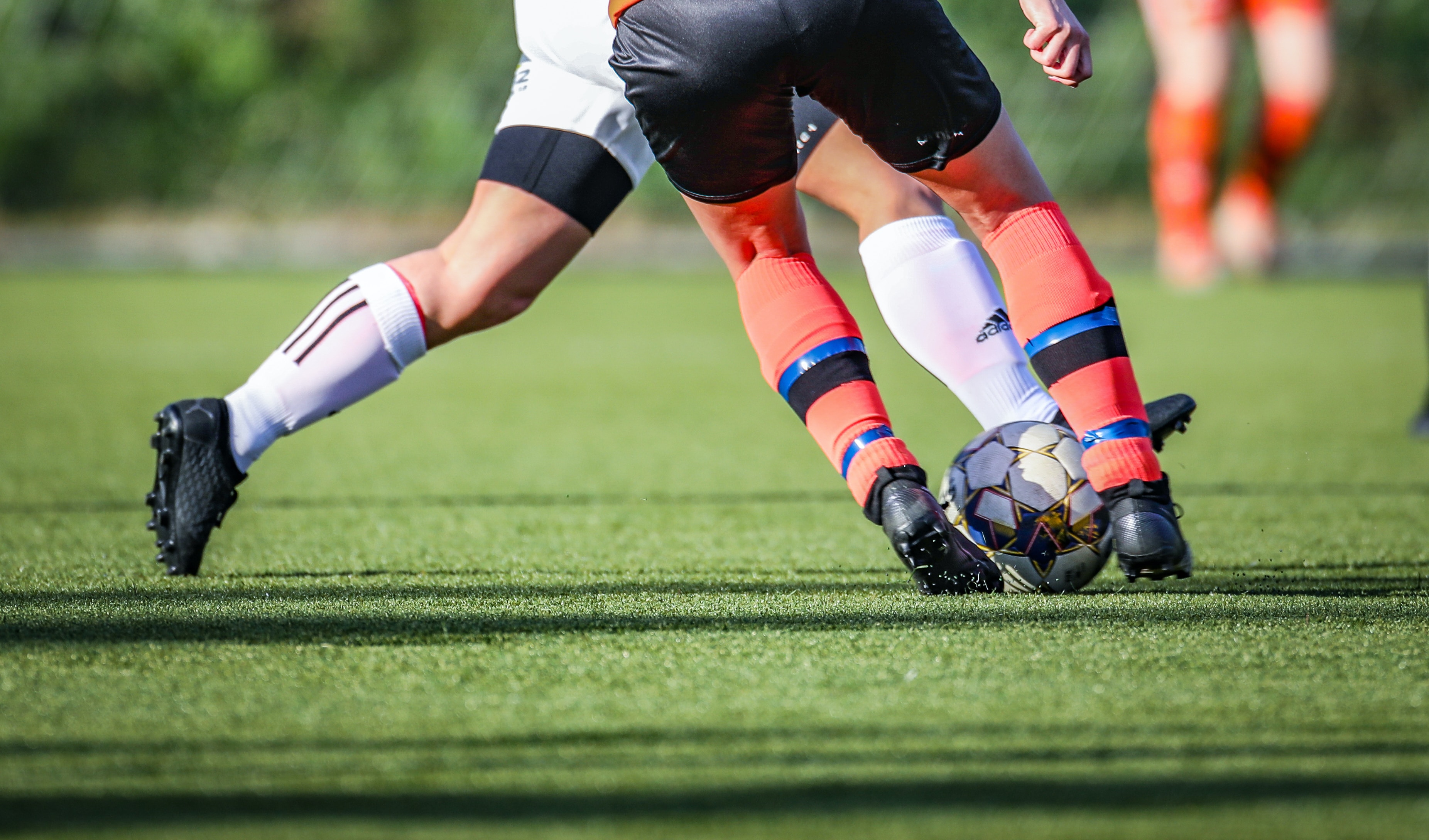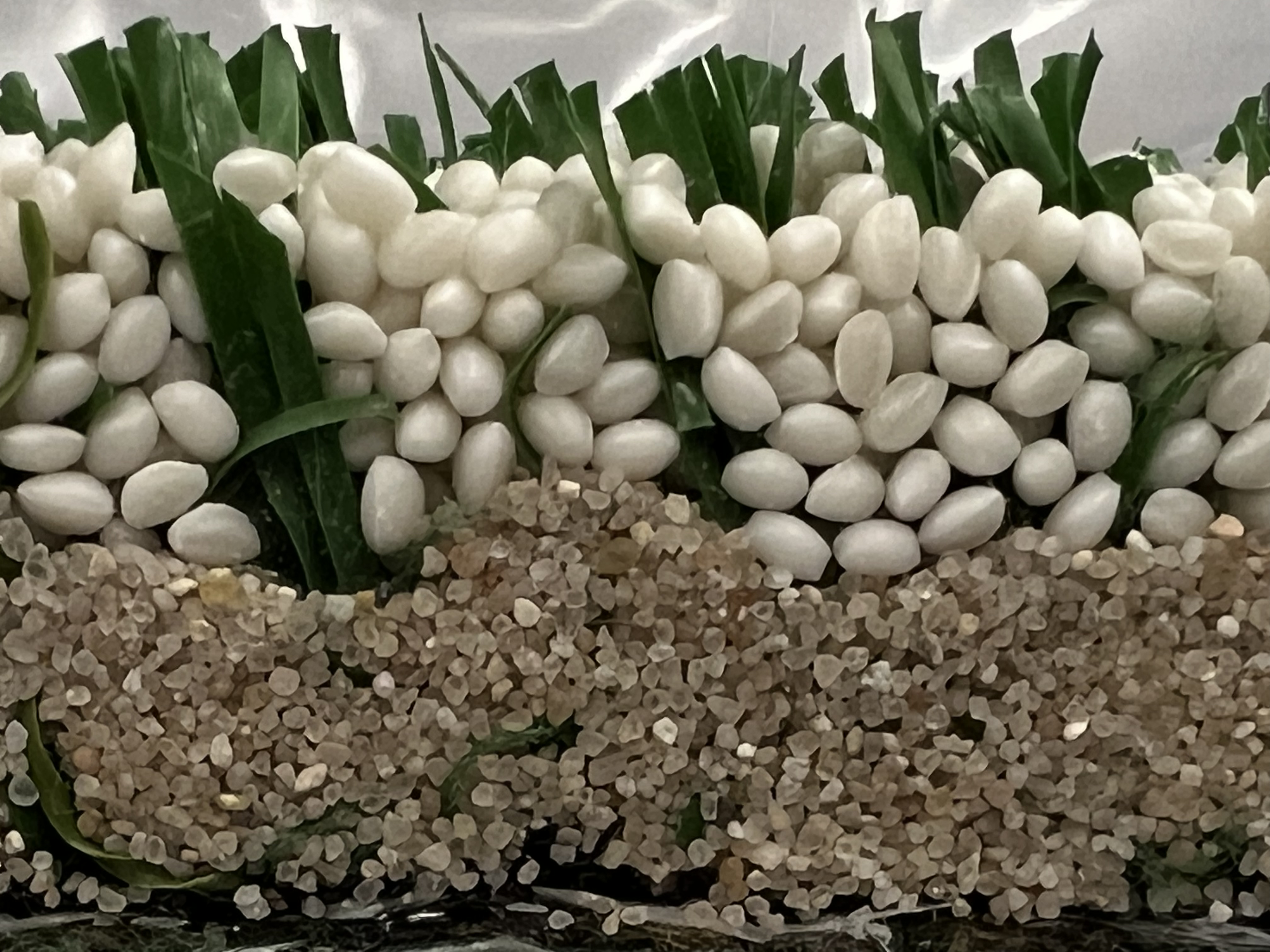Main navigation
Eco-friendly artificial turf: a sports pitch that’s good for people and the environment
There are thousands of artificial turf pitches in Germany. They are extremely practical, but often not at all environmentally friendly. When it rains or the pitch is used, plastic particles from the rubber granules can be released into the envronment, where they remain. Researchers at the University of Stuttgart along with a company called TECNARO are now developing an artificial turf with an infill that biodegrades as soon as it leaves the pitch. One of the first eco-friendly artificial sports pitches in Germany will be installed in the city of Ellwangen in the next few months.
Most communities have a sports field for local football and athletics clubs, school sports or afternoon kickabouts. Most of these fields originally consisted of natural grass. However, grass pitches require a lot of maintenance, sand and ash pitches are too hard to play on and can lead to injuries. As a result, natural grass is increasingly being replaced by artificial turf. Unlike its natural counterpart, artificial turf can be used all year round and is easier and cheaper to maintain. The huge expense of watering natural turf is one of the main arguments in favour of artificial turf in our increasingly hot and dry summers.
Infill granules from end-of-life tyres remain in the environment for centuries

Using artificial turf would be a great idea if it weren't for the environmental issues. The basic structure of grass rolls and mats isn’t the main problem. They consist of blades of artificial grass that are pulled through a backing fabric like stitches in a sewing machine and then fixed in place. An elastic underlayer ensures softness and elasticity to protect the athlete's joints and the turf from tread damage. Together with additional fibres, each with different properties, this gives the feel of natural grass. Well, almost. However, to make it suitable for sports use, the top layer of fibres is filled with different types of infill granules. The type of granules used depends on the sport the pitch is designed for and the desired play characteristics. This infill consists of sand and an additional material, e.g. natural infill elements such as crushed olive stones, corn husks or cork, especially on older pitches, but often also rubber granules from end-of-life tyres.
This is hazardous waste, which would not be a problem if the rubber granules stayed where they were. But this is not the case: the weather and athletes cause rubber granules to be released from the artificial turf, for example when it rains or when the infill beads stick to the shoes and jerseys of pitch users. The European Chemicals Agency (ECHA) estimates that up to 16,000 tonnes of microplastics are released each year across Europe. These plastic particles are harmful substances that no one wants in the soil. What’s more, the plastic particles do not degrade and remain in the soil for centuries. This is why artificial turf has long been criticised, sparking an intense debate on sustainability. ECHA has also advised the European Commission to ban the use of plastic granules on artificial turf. Manufacturers and the sports industry are now urgently looking for viable alternatives.1)
Eco-friendly turf is made mainly of natural materials

That is why researchers at the Institute of Plastics Technology IKT and the Institute of Biomaterials and Biomolecular Systems IBBS at the University of Stuttgart, together with the biopolymer company TECNARO from Ilsfeld, have been working for some time on the development of artificial turf made from biobased materials. Their work has been successful and the first eco-friendly sports field is currently being installed in the Baden-Württemberg city of Ellwangen. "This sports-compatible artificial turf sports field will be the first in Germany to be made predominantly from renewable raw materials. In addition to its environmental benefits, the system will also save fossil resources," says Felix Baumgärtner, head of the IKT working group conducting the research. "This will continue to be an exciting project for us scientists, as we will be conducting studies on the playability of the pitch and its actual environmental impact as well as doing other things such as a complete life cycle assessment. The sports field in Erlangen will be used as as a model and showcase. We will involve users and local residents as well as students to build comprehensive knowledge that will feed into the construction of other sports facilities."
The technical sports properties - i.e. the suitability of the turf for sports activities - are an important element, as is the environmental compatibility of the material: "This has always been the sticking point with natural infill materials such as olive stones," Baumgärtner explains. "Alternative materials naturally have different playing characteristics, the ball bounces differently, which is also an important aspect in terms of player safety. No natural material has yet come close to rubber infill."
This is about to change. The researchers have developed a plastic made of biomaterials that is expected to have properties similar to those of rubber infills. The material developed by TECNARO, which will be used to fill the artificial turf roll, is called Arboblend®. When used on sports pitches, it has similar properties to rubber granule infill. Although it is biobased and biodegradable, the innovative material will also be highly weather-resistant. It will also start to degrade when it leaves the pitch and is released into the environment. It will degrade almost completely: 90 percent of the organic granules are expected to decompose within twenty-four months in soil and six months in water.
Biodegradation only starts outside the pitch
It sounds good and works in the laboratory, at least as the fibres are concerned. "TECNARO is still working on the perfect formulation and on the possibility of adding as many naturally occurring substances as possible to the fibre layer," says the plastics expert. "Development of the infill granules is still ongoing. The idea is that soil microorganisms with the appropriate enzyme systems will break down the discharged granules, but their activity will be inhibited as long as the infill is in the plastic roll. This is achieved by antibacterial activity of the artificial turf. The organic plastic thus remains stable for longer. However, biological degradation starts with a short time lag once the beads leave the sports field.
We support the development of the formulations at the university on a laboratory scale, which then happens on a larger scale at TECNARO. The sports field will later be built by a company that is also responsible for the overall properties. This also includes preparation of the subsurface, among other things."
Before the sports field in Ellwangen is built, the researchers will carry on developing the granules over the next few months as well as carrying out various tests to determine the ideal formulation for the fibre material: "In addition to the numerous environmental requirements, the formulation must be easy to process. We are currently focusing on fine-tuning the recipe," says Baumgärtner. "And we are then hoping that the positive effects of the innovative infill on the environment will quickly be noticeable."
Project "NaKuRa: Sustainable artificial turf pitch – development and investigation using the city of Ellwangen as example"
Duration: 1 July 2022 until 30 June 2025
Institutes and industrial partners involved:
- Institute of Plastics Technology IKT and the Institute of Biomaterials and Biomolecular Systems IBBS at the University of Stuttgart
- TECNARO Gesellschaft zur industriellen Anwendung nachwachsender Rohstoffe mbH
Supported by:
- Morton Extrusionstechnik GmbH, FieldTurf Tarkett, the city of Ellwangen, Ministry of Rural Affairs and Consumer Protection Baden-Württemberg, Ministry of the Environment, Climate Protection and the Energy Sector Baden-Württemberg, Federal Institute of Sport Science, Landessportverband Baden-Württemberg
Funding and support through:
- Federal Ministry of Food and Agriculture and Agency for Renewable Resources
References:
1) European Chemicals Agency: Hot Topics: Mikroplastics. https://echa.europa.eu/hot-topics/microplastics